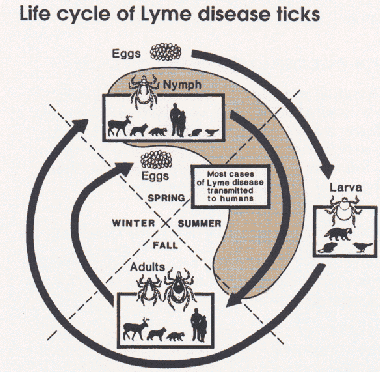Borrelia burgdorferi and Lyme Disease (page 3)
(This chapter has 6 pages)
© Kenneth Todar, PhD
Transmission of Lyme Disease
Lyme disease is spread by the bite of ticks of the genus Ixodes
that are infected with Borrelia burgdorferi. Ixodes,
commonly
known as the deer tick (or bear tick), normally feeds on the
white-footed
mouse, the white-tailed deer, and certain other mammals. It is
responsible
for transmitting the spirochetes to humans in the northeastern and
north-central
United States. On the Pacific Coast, the bacteria are transmitted to
humans
by the western black-legged tick, and in the southeastern
states
by the related black-legged tick.

Distribution of Ixodes
ticks that transmit Lyme disease in the U.S. CDC.
Ixodes ticks are much smaller than common dog and cattle
ticks.
In their larval and nymphal stages, they are no bigger than a pinhead.
Adult ticks are slightly larger. The tick nymphs, which are most likely
to feed on a person and are rarely noticed because of their small size
(less than 2 mm), are usually involved in the transmission of the
disease.

Ixodes ticks: larva,
nymph, adult male, adult female. CDC.
Spirochete prevalence in adult Ixodes ticks is highly
variable depending on geographic location. It was shown
to
be present in approximately 35% of ticks in the Baraboo Hills northwest
of
Madison,
Wisconsin, while in regions of California, 2% prevalence has been
reported, and in
regions of New York, 50% has been reported.
For Lyme disease to exist in an area, at least three closely
interrelated
elements must be present in nature: the Lyme disease bacteria, Borrelia
burgdorferi, ticks
that
can transmit them, and mammals
(such as mice and deer) to provide food
for the ticks in their various life stages.
The tick life cycle
consists
of three distinctive stages: larvae, nymphs, and adults. A blood meal
is
required for ticks to molt from the larvae stage to the nymph stage and
from the nymph stage to the adult stage. The tick larvae and nymphs
typically
become infected with Borrelia burgdorferi when they feed on
infected
small
animals, particularly the white-footed mouse. The bacteria remain in
the
tick as it changes from larva to nymph or from nymph to adult. Infected
nymphs and adult ticks then bite and transmit the bacteria to
other small rodents, other animals, and humans, all in the course of
their
normal feeding behavior. Adult ticks preferentially feed on the
white-tailed
deer, which thereby becomes an important reservoir in regions of
infestation.
The tick life cycle takes two years to complete (see diagram below).

Lyme disease occurs in domestic animals, as well. In dogs, the
disease
usually presents as arthritis. Domestic animals can carry infected
ticks
into areas where humans live, but whether pet owners are more likely
than
others to get Lyme disease is not known.